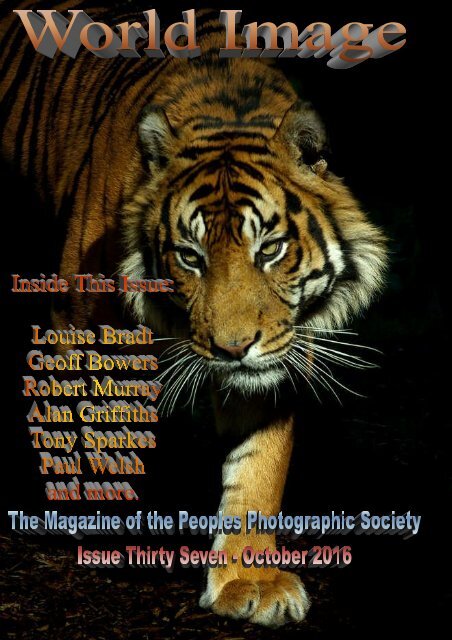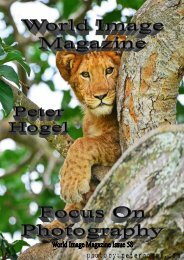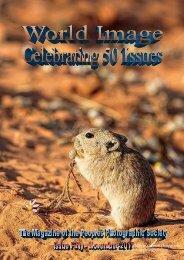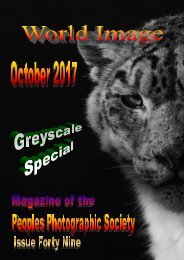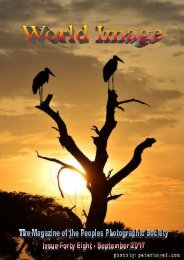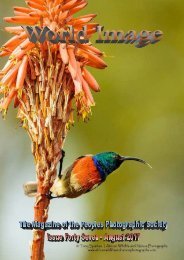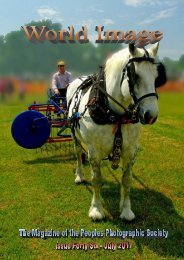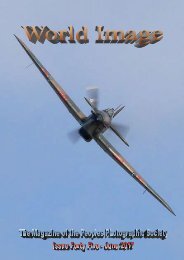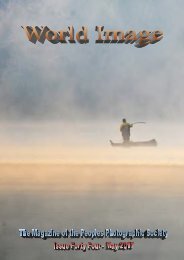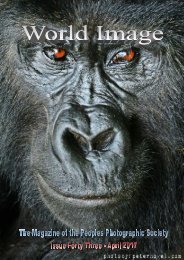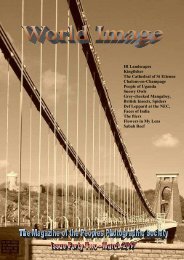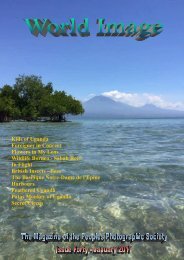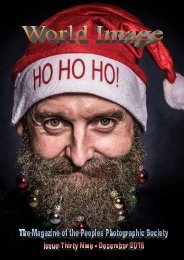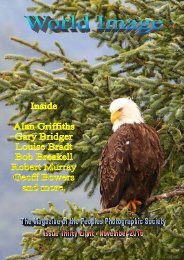World Image Issue 37 October 2016
Create successful ePaper yourself
Turn your PDF publications into a flip-book with our unique Google optimized e-Paper software.
Website = photosociety.net Page 1 email = magazine@photosociety.net
National and Regional Management<br />
Gordon Longmead - England - CEO<br />
Peter Hogel - Uganda - Deputy CEO<br />
Scott Hurd - Namibia<br />
Tom Coetzee - South Africa<br />
Paul Welch—Australia<br />
Steve Cook - USA<br />
Robert Murray - Scotland<br />
Tina Andreasson - Sweden and Mexico<br />
Jack Glisson - Kentucky USA<br />
Rodger Lee - Steam Punk Events<br />
Contents:-<br />
4 A Study in Greyscale - Structure by Alan Griffiths<br />
6 Greyscale verses Black and White verses Mono<br />
7 Macro Magic - Close-up and Closer<br />
8 An Interview with Photographer Louise Bradt<br />
12 Kabaka’s Lake, Ugandaa - Ben Oleni Ntale<br />
14 A Splash of Colour by Tony Sparkes<br />
16 The Close Up <strong>World</strong><br />
18 Freebee or Not to Freebee? That is the question.<br />
20 Travel Photography – Snaps or <strong>Image</strong>s by Geoff Bowers<br />
22 Gardening - The Challenge of the Attention Seekers<br />
26 Photo Spot - Robert Murray<br />
28 Fire and Burning and some common Trees of the Kruger. Ian Bales-Smith<br />
34 Wildlife Borneo - Another Day in Paradise - Sabah Reef by Gary Bridger<br />
36 Photospot<br />
© Please remember that all articles and images published in this magazine are copyright protected<br />
Cover picture - Tiger by Gordon Longmead<br />
Website = photosociety.net Page 2 email = magazine@photosociety.net
Picture by Matthew (A true photographer, he could not resist)<br />
Website = photosociety.net Page 3 email = magazine@photosociety.net
Post processing<br />
wedding photog<br />
best possible im<br />
Any photograph<br />
will do the sam<br />
obvious to the o<br />
has been mani<br />
images.<br />
The most impor<br />
result is what th<br />
not cater for the<br />
be true to oursel<br />
Greyscale come<br />
seen landscape<br />
greyscale and in<br />
Website = photosociety.net Page 4 email = magazine@photosociety.net
Website = photosociety.net Page 5 email = magazine@photosociety.net
One aspect of photography has always interested me<br />
and that is the differences in interpretation of the<br />
basic styles of photography and its effects.<br />
So here we have my own interpretation of the<br />
effects as I saw them , or at least remember them. I<br />
have included the original colour image as a<br />
reference, the rest are digitally modified to as close<br />
an approximation as possible to my memories.<br />
Soon we had the 286 shades of grey which gave us<br />
the true greyscale pictures. Exposure meters were<br />
already set to 18% grey which gives us the ‘perfect’<br />
exposure.<br />
This picture shows how the camera sensor sees the<br />
colour image … in greyscale.<br />
The first images I ever remember seeing were called<br />
Soot and Whitewash. There was no grey in the<br />
picture. This was how photography started out back<br />
in the 1860’s and how my father introduced me to<br />
photographic processing in the darkroom.<br />
As time went by the advances in film and paper<br />
technology meant that the intermediate colours in a<br />
picture could be recorded in shades of grey,<br />
although they still retained much of the soot and<br />
whitewash aspect as only a few shades of grey were<br />
accessible.<br />
Mono used to mean any of the three styles already<br />
mentioned, but lately it has come to mean any image<br />
produced in shades of one colour.<br />
Website = photosociety.net Page 6 email = magazine@photosociety.net
Macro Magic<br />
Close-up and Closer<br />
Agate Rock by Georgene Bergstrom<br />
Baby Pine Cones by Georgene Bergstrom<br />
Trio (above and right) by Peter Hogel<br />
By Martin Clarke<br />
Website = photosociety.net Page 7 email = magazine@photosociety.net
An Interview with Photographer Louise Bradt<br />
In light of our development of the magazine I managed to squeeze some time from her busy schedule to<br />
interview Photographer and volunteer Fire-fighter Louise Bradt. Louise has been a member of the Peoples<br />
Photographic Society since November 2013 which qualifies her as one of the founder members and a<br />
society stalwart.<br />
As many people move around as they progress through life, I asked Louise “What part of the <strong>World</strong> do you<br />
originate from and where are you now?”<br />
I was born and raised in Congleton, Cheshire, England, but now live in NW Arkansas in the US. My<br />
husbands job brought us to the States in 2011, and we started out in a Los Angeles suburb which I hated.<br />
Thankfully he was head-hunted by Wal-Mart and we made the decision that rural NW Arkansas was a much<br />
better place to bring up 2 teenage boys – so we moved in December 2012, and hubby managed to escape<br />
Wal-Mart after 12 months (phew)<br />
As we all need to begin somewhere I asked “What made you start out in Photography?”<br />
Not sure really, I remember as a kid just loving taking photographs at silly angles and of people when they<br />
least expected it. It progressed from there really. I guess I didn’t really start to take it more seriously until<br />
around 2006 when I got my first digital camera though.<br />
Website = photosociety.net Page 8 email = magazine@photosociety.net
“I am always interested in what equipment we started out with, what was your first camera or what were<br />
your first cameras?”<br />
The first camera I remember owning was a little instamatic 110, then I had no camera for the longest time<br />
and then I was lucky to have one of the first Sony Cybershot point and shoot camera’s. Eventually I found<br />
my way to Nikon with a D40, which I still own, then a D90 and now I have a D610 and now generally use a<br />
D4s, it’s awesome!<br />
“Ok, so you are out on a countryside walk with your D4s, what would be your favourite or preferred lens to<br />
be using?”<br />
On a countryside walk at the moment I would take my 24-70mm f/2.8. It is the most versatile lens I have.<br />
“Have you done wedding photography and on a shoot such as weddings or parties, do you prefer to be the<br />
main or the candid photographer?”<br />
No I haven’t and I never intend to – that is something I plan to leave to the stress junkies! I prefer candid to<br />
posed images so at parties and events I would always be the candid photographer.<br />
“Some people have a studio setup either at home or as a professional studio, how about you, do you prefer<br />
studio or natural photography?”<br />
I do have a studio setup, I have Bowens lighting but also a Profoto D1 strobe, but natural photography is<br />
always my preference.<br />
“How often do you try and get out to take pictures, and do you make special photographic trips?”<br />
I usually have my camera with me – you never know what<br />
you might see and where you might see it. I have not made<br />
any special photographic trips. I take photographs of<br />
wonderful places we visit, but have never worked it the other<br />
way around. Of course if the Rogers Fire Chief consents to<br />
let me retry my project with the Rogers FD, I will be<br />
making special trips to go and hang out at the various fire<br />
departments around the city.<br />
“When on holiday, do you just take holiday pictures or also<br />
look for ‘specials’ from a photographic viewpoint?”<br />
I am always looking for the best angle/vantage point for a<br />
shot. If I am taking snaps, I use my phone camera.<br />
“Photographers have a love hate relationship to post<br />
processing, what extent do you use it?”<br />
I would love to say that I never post process, but that would<br />
be a lie. I try to keep it to a minimum by getting my shot as<br />
clean as a I can when I take it, but there is usually a little<br />
tidying up, here and there.<br />
“What software do you prefer to use?”<br />
I am a Photoshop lover and have been since the days of Photoshop CS3.<br />
Website = photosociety.net Page 9 email = magazine@photosociety.net
“In light of the current trends, do you consider yourself to be a professional, ProAm, or Amateur?”<br />
Hmmmm…..I try not to label myself….So much I have learned so much still to learn – always a new<br />
adventure to follow……I will say ProAm because I know a lot more than some and way less than some<br />
too…..I am certainly not arrogant enough to think I know it all !<br />
“How would you describe yourself as a photographer?”<br />
I see myself as an Adventurer when it comes to photography. I have developed a lot of skills over the years<br />
but there is always more to learn and to explore, so it is like a giant adventure I am on, always seeking to<br />
improve and discover new and exciting things!<br />
“What journey did you take to get the style you adopt today”?<br />
I am still on the journey…I have a passion for contrastly<br />
black and white portraiture this much I know, and huge<br />
ocd’s about horizons being straight, and I have a keen<br />
eye for specks of ‘stuff’ that shouldn’t be on a finished<br />
image, and once you see you can’t unsee again! But as<br />
for a specific style, I don’t think I have one.<br />
I can tell you that I am never going to be the person<br />
producing those overly exposed wedding images that<br />
people love so much, and I am never going to be the<br />
person you come to when you want a photographer to<br />
take 20lbs off you….<br />
I guess my style is ‘real life’ if I have to put a label on it…I love people, as they are, warts and all – to me<br />
that’s character and photographing people which is what I do most of, is all about finding that character and<br />
bringing it out.<br />
“So what sort of things give you inspiration when looking<br />
for your images and what would be your ultimate<br />
project”?<br />
I am inspired by the world and its occupants around me,<br />
overloading my senses! My ultimate project is one I<br />
secured a year ago and then did nothing with! I am a<br />
Volunteer Fire-fighter. Here in the US the are approx. 1.1<br />
million fire-fighters – approx. 300,000 career firefighters<br />
(paid) and approx. 800,000 volunteer firefighters.<br />
The paid department that my department is attached to – Rogers Fire Dept is one of only 64 depts. in the<br />
whole of the US to have achieved an ISO rating of 1 (the highest possible). I contacted the Fire Chief at<br />
Rogers FD to ask his permission to write an article on their amazing achievement and to follow the firefighters<br />
around photographing them doing what they do best, putting out fires…<br />
As a fire-fighter myself, this meant that I would be able to get myself into positions that photographers are<br />
not normally permitted to get themselves into because of the obvious dangers involved. This could have<br />
been a career changing event for me. I let my realisation of the scale of the task and my fear as a female<br />
having to hang out through long nights with male shift units stop me from even starting the task.<br />
Website = photosociety.net Page 10 email = magazine@photosociety.net
Now I am in a position where I am going to have to re-contact the Fire Chief, eat humble pie and ask him if<br />
we can start again on this project – I have no clue if he will say yes. I can only hope that the reputation I<br />
have built for myself as a volunteer fire-fighter within the county (people do talk about me, including the<br />
fire marshal), will stand me in good stead and persuade him to give me a second chance!<br />
“If you could only take one image and never use a camera again what would be the subject?”<br />
A fire-fighter exiting a burning building, tired and exhausted, but successful in his task…It is a truly<br />
awesome sight and to capture it perfectly would be a dream.<br />
“Do you have a favourite genera if so what?”<br />
I love to photograph people, but I am always exploring new ideas and subjects. I also love photographing<br />
wildlife and have recently started to take an interest in landscape<br />
“Have you ever taken courses on photography or are you self taught”?<br />
For the most part I am self taught. I have taken a few course more recently to confirm to myself that what I<br />
believed was correct is actually correct and I am pleased to say, I have not taught myself anything wrong,<br />
which is always a relief.<br />
I did consider doing a Masters in Digital Photography, but I was advised by several very successful<br />
photographers that with my skill set it wasn’t really going to ‘do’ anything for me other than drain our bank<br />
account.<br />
“What is the most satisfying image you have ever<br />
taken”?<br />
There are two – this one is what we call the<br />
Shakespearean shot of my husband Steven and the<br />
other is of a fellow fire-fighter, Ed Dawson..<br />
Both these images have achieved most acclaim on<br />
various photographic websites etc which is always<br />
good for the ego<br />
“What was the most difficult image you<br />
have taken”?<br />
The most difficult shot I have ever taken so<br />
far was probably the landscape shot I did<br />
from the front of our home at dawn on New<br />
Years Day in 2013.<br />
I was out in the freezing cold for what<br />
seemed like hours before I got what I<br />
believe is the best landscape shot I have<br />
taken to date.<br />
Website = photosociety.net Page 11 email = magazine@photosociety.net
“What was the most dangerous situation you have placed yourself in to get the picture”?<br />
Burning buildings are pretty dangerous – In full turnouts it is easy for me to take my camera a lot closer<br />
than is safer for it, rather than is safer for me.<br />
I can also been seen dangling off the side or back of our bowrider out on the lake taking photographs of my<br />
son or hubby while they are water-skiing…That can be a little hairy at 40mph – especially if you hit a wake<br />
or something!<br />
“Do you admire any particular photographer and why”?<br />
Alan Shapiro – he produces the most stunning black and white portraiture I think I have ever seen.<br />
Clay Patrick McBride – the man is totally nuts, creates some wacky images but he goes with what he feels<br />
inside and people love that. The guy photographs lots of superbly famous people and I admire his ability to<br />
stay true to himself.<br />
When people used to tell me that I would have to conform to what society wanted if I was going to be<br />
successful, I would look at Clays work and say “nah, I don’t think so…I think being Lou Bradt works pretty<br />
well”<br />
“Do you operate a business relevant to the art of photography”?<br />
I am currently working on building Lou Bradt Photography…..softly softly catchy monkey as my Mum<br />
always says….I am getting there.<br />
Rooster Tail by Louise Bradt<br />
Website = photosociety.net Page 12 email = magazine@photosociety.net
Kabaka’s Lake is situated within a few kilometers of<br />
the city centre in Kampala the capital city of<br />
Uganda.<br />
Although the lake has no major tributaries, the water<br />
levels remain constant throughout the year.<br />
This lake was dug by hand on the orders of King<br />
Mwanga II from 1885 to 1888 to create a channel<br />
wide enough for him to travel by boat to Munyonyo<br />
where he had built another palace at Mulungu hill<br />
near Lake Victoria.<br />
There are two excavated lakes in East Africa,<br />
Kabaka’s Lake is a beautiful with two islands in the<br />
middle of it and has developed into a sanctuary for<br />
many rare aquatic animals and plants.<br />
Kabaka’s Lake is one of the biggest lakes in Africa<br />
covering approximately two square km and 200 feet<br />
deep.<br />
Although history taints him as the worst of the<br />
Kabaka's (Kings) Buganda Kingdom ever had,<br />
especially for execution of early foreign religions<br />
converts dubbed the Uganda Martyrs.<br />
However, Kabaka (king) Danieri Basammula-<br />
Ekkere Mwanga II Mukasa is the reason this<br />
beautiful lake exists!<br />
Website = photosociety.net Page 13 email = magazine@photosociety.net
Malaysia and the Long-tailed Sibia (Heterophasia picaoides)<br />
again. This time a vertical 'portrait' version<br />
I took in South Africa a while ago, a male Marico Sunbird<br />
(Cinnyris mariquensis) these colourful birds are found in<br />
Southern and Eastern Africa.<br />
I captured this fleeting glimpse of an adult male Black-throated sunbird (Aethopyga saturata) whilst on our<br />
recent trip to Fraser's Hill, Pahang, Malaysia.<br />
Website = photosociety.net Page 14 email = magazine@photosociety.net
The Forked-tailed Drongo (Dicrurus adsimilis) also has a<br />
striking red eye similar to the Long-tailed Sibia from<br />
Malaysia posted a few days ago. The Drongo was taken in<br />
South Africa's Kgalagadi Transfrontier Park.<br />
A nice portrait showing off the gorgeous colours of the<br />
beautiful little Violet eared Waxbill (Uraeginthus granatinus)<br />
at a waterhole in the Western Cape, South Africa<br />
A juvenile Oriental Magpie Robin (Copsychus<br />
saularis) captured at the bird bath at Stephens Place<br />
( ReallyWild Place) Fraziers Hill, Malaysia.<br />
Malaysia and another bird species, nothing as colourful as<br />
before but a new species for me, I like that red eye.. The Long<br />
-tailed Sibia (Heterophasia picaoides) Wiki says its<br />
distributed through central Nepal and North east India,<br />
Bhutan, Southern China, Laos, Malaysia (where I saw it),<br />
Myanmar, Nepal, Thailand and Vietnam, as well as Sumatra.<br />
It is found in evergreen forests, oak and pine forests,<br />
secondary growth, scrub with large trees and forest edge<br />
habitats<br />
Website = photosociety.net Page 15 email = magazine@photosociety.net
Our recent Malaysia trip....Another view of my Purple Femur Tarantula (Coremiocnemis hoggi) coming out of her h<br />
in the bank. A night walk under taken under external 'flash' so warmed it up a little.. Tony Sparkes<br />
Stinkhorn, one of those close-ups that you do not want to<br />
Website = photosociety.net<br />
get the nose close up<br />
Page<br />
to.<br />
16<br />
Gordon Longmead<br />
email = magazine@photosociety.net
Dragon fly taken at my local RSPB reserve. - Rodger Lee<br />
And some you just can’t resist Gordon Longmead<br />
Website = photosociety.net Page 17 email = magazine@photosociety.net
Freebee or Not to Freebee? That is the question.<br />
And a very good question it might be, if it was not so silly.<br />
So let us begin with the arguments.<br />
Allowing a magazine to use your pictures without payment is not acceptable. This is fine if you are a<br />
recognised professional but it needs to be remembered that most magazines do not accept anything other<br />
than commissioned pictures. If they commission them they need to be paying for them, no question.<br />
So in the very unlikely event that a mainstream ‘for profit’ magazine contacts an amateur to use one of their<br />
pictures for their articles, should they pay? Yes they should, after all the magazine is only interested in<br />
making profits and it is only right that the photographer should share in those. The only reason they contact<br />
the amateur is probably that they can’t get a suitable professional image before their deadline.<br />
Allowing a magazine to use your pictures without payment is damaging to the photographic profession by<br />
depriving photographers of an income. Really? Less than 0.01% of photographers are true professionals, the<br />
vast majority are aspiring amateurs, and those really good amateurs are by definition not in the photographic<br />
business and thus not professionals.<br />
What this argument is really stating is that no one should offer their images to a magazine because that<br />
0.01% might lose their income. Since as stated previously, most magazines commission photographers, that<br />
aspect is very unlikely. Fact is that if we are expecting to get paid for our pictures we are no longer enjoying<br />
it as a hobby.<br />
It is this last fact that is the most important of all. As a hobby or amateur photographer, the greatest thrill of<br />
all is to see your image in print or winning a competition. As a Professional, competition is irrelevant unless<br />
it is of global interest and then only as a means of getting noticed. Getting into print is the pay check, like<br />
the commissions, it is where your money comes from.<br />
So I will leave this section with a thought for you to ponder, if a mainstream magazine publishes an<br />
amateurs picture, paid or otherwise, over yours as a professional, it means theirs was better suited to the<br />
task. Can you do better for the next time?<br />
Now let us focus on the second part of the task.<br />
If you are one of the 5000 (yes it varies) reading this magazine, then you are doing so for free. If you belong<br />
to the Society, you do so for free. Those who are supporting the magazine with articles and pictures are<br />
doing so because they believe in the magazine. They also believe that although it is unpaid, it showcases<br />
their work, it encourages others to realise that they can also produce the quality images and not be put off by<br />
the ‘well they are professional, they should be good’ attitude. While we do have the support of<br />
professionals, most of what is on these pages is written and produced by ordinary people with ordinary<br />
cameras and even camera phones. The most important part of the whole statement is that ‘THEY BELIEVE<br />
IN THE MAGAZINE’.<br />
If those supporting the magazine or the society suddenly wanted to get paid for their images and stopped<br />
sending them in, it would cease to exist. But perhaps that is what the mainstream magazines want, perhaps<br />
they are realising that if magazines like this one were allowed to flourish and cater for the ordinary<br />
photographer, their own empires might take a hiding.<br />
Website = photosociety.net Page 18 email = magazine@photosociety.net
At this point we should also perhaps look at the other side of the arguments that are getting lost in the hype<br />
about the professionals as previously discussed.<br />
We are all in this to be noticed, either by those who just enjoy seeing the pictures and images of places they<br />
will probably never be able to visit, our piers who offer constructive comment, (destructive comment is not<br />
worth anything and only shows the makers poor intelligence), and possibly, just possibly, by those looking<br />
to buy images for mainstream press (he he) or for their walls.<br />
For the people involved in safari or travel businesses, showing pictures on the internet in chat rooms and<br />
other social media is not only welcomed, but actively encouraged, why? Because those images are a shop<br />
window to show others what they might see if they visit. My own visit to Uganda was inspired by the<br />
images presented to me by Peter Hogel of Eden Adventures (who happens to be vice-chairman of this<br />
magazine and of the peoples Photographic Society). Would I have considered going there otherwise? No,<br />
my home range is the Alps.<br />
Beyond the kudos there is no other reward for showing our pictures to those who enjoy or our piers, most of<br />
us would be quite pleased if someone thought our pictures good enough to warrant copying from the<br />
internet for personal use.<br />
Most internet images are low resolution and not really any good for commercial use. My own are generally<br />
about 1mb and many are 500kb neither of which are much use above postcard size, or A4 for the 1mb files.<br />
If you want to upload 5mb or larger files then the fault and the risk is yours. Many sites reduce those files to<br />
thumbnail files, others have a built in defence against general copying although even that is not totally<br />
secure. You could apply a copyright mark but poorly done it will spoil the picture and viewers will simply<br />
skip past them. Meta Data is no protection as it can be removed by anyone with processing software.<br />
But what of those who take your image from the internet and use them for profit making purposes? Or<br />
worse still, take your image and represent it as their own and offer it for sale?<br />
That is both illegal and immoral. The worst culprits are the Chinese and there is nothing you can do about it<br />
until the products they make from your pictures hit the open market place. Then you can take action against<br />
the sellers, unfortunately those people probably have no idea that the images on the products are stolen.<br />
There has over recent years been a number of incidents of this type of theft that can and should be dealt with<br />
the most severity, and that is when a person steals an image and then claims it as their own. It is<br />
unimportant if that is done for commercial purposes or just personal credit, it is not acceptable.<br />
It is my view that such people should be ejected from any form of photographic society or club, banned<br />
from entering any photographic competition, and, in the case of formally recognised ‘professional’<br />
photographers, should also be rejected as a photographer by all media outlets. On a strictly personal level I<br />
would also turn my back on them in my social life.<br />
Whilst we applaud the actions of the professional photographic bodies for taking actions against those<br />
stealing images for profit and kudos, we must speak out against the fear such actions are generating in the<br />
millions of photographers who just post to be seen and for others to enjoy what they do.<br />
If someone wishes to buy your image for their home or office, or a mainstream ‘for profit’ magazine wants<br />
to publish your image, they will contact you and pay you for the high quality picture file. The magazines<br />
only want files of 20mb or more, and anything less than 5mb will not put a good image on the office wall.<br />
As there are no pictures I doubt anyone will take the time to read this article properly, but it has to be said.<br />
If you made it this far … well done.<br />
Gordon<br />
Website = photosociety.net Page 19 email = magazine@photosociety.net
I love to travel and I love taking photographs, but sometimes I have<br />
to choose which I’m doing.<br />
To state the obvious travel means moving from place to place.<br />
Often photography involves lingering in one place. It seems to me<br />
the trick is combining both. So snap while moving and linger for the<br />
images? Well yes that’s what I try to do.<br />
The great advantage of travelling with<br />
digital cameras and large memory cards is<br />
that I can shoot lots of frames, so I do.<br />
Deleting once I have them on the computer<br />
is easy. All I keep are the memory shots,<br />
the ‘been there seen it’ ones.<br />
The problem I find is which lens to put on<br />
the camera. My best lenses are Olympus<br />
Pro ones.<br />
7-14mm ultra wide angle of St Marks square un edited - verticals not<br />
corrected<br />
I have a wide angle 7–14 mm, a 12–40 mm, and a 40-150mm<br />
with a 1.4 extender. These all offer a fast aperture of F2.8 or F4<br />
for the long one with the extension fitted.<br />
It often seems to be a<br />
rule that which ever one<br />
I have on I wish I had a<br />
different one fitted. This<br />
is especially true when<br />
outdoors.<br />
12 - 40mm wide angle at Singapore's Gardens<br />
by the bay watching the light show<br />
I either can’t get close<br />
enough or far away<br />
enough. My usual<br />
solution is to fit my 15-<br />
150 travel lens.<br />
15 - 150mm Monkey and baby in Gibraltar<br />
Website = photosociety.net Page 20 email = magazine@photosociety.net
This is a lower cost lens with apertures of F4<br />
to F5.6. It is also a lot lighter in weight so<br />
good when touring around and getting in and<br />
out of vehicles.<br />
This lens is great for snaps and some serious<br />
stuff, but does not quite have the clarity of the<br />
Pro lenses, nor is it so good in low light.<br />
When I go away in the car I can easily take all<br />
my stuff. There’s my older camera, tripod and<br />
other lenses I accumulated over the past few<br />
years plus the bits and pieces like filters,<br />
cleaners, bean bags etc. It’s when I fly that I<br />
have to make the decisions.<br />
15 - 150mm intermediate action shot<br />
The Kilograms soon add up. One camera – with the<br />
12-40mm fitted (good for snaps in the airport and<br />
not to bulky) tripod, travel lens, ......... Damn it, pack<br />
it all, and take fewer clothes. Makes sense to me if<br />
not to the rest of the family – and I am the senior.<br />
Then there’s the problem of changing the lens on the<br />
moving locations. Crowded places, wind blowing<br />
the dust or its raining all making things difficult.<br />
Other people on a tour move on and I’m getting left<br />
behind. So my trusty travel lens does more work.<br />
I get the snaps for the memories and they are only<br />
just for me and the family. When we stop I can find<br />
time to change the kit and take a few minutes to<br />
shoot some different stuff.<br />
40-150mm pro long lens with 1.4 extender zoomed out to get a<br />
view of the bottom of Grand Canal<br />
This does make for some rushed lunches and accusations of being unsocial but what the heck – I’m just an<br />
eccentric old guy.<br />
Geoff Bowers.<br />
So just to give an idea of my 15-150 travel lens, the first image is zoomed to 14mm,<br />
then out to 25mm for the second and finally I zoomed out to 150mm for the dragonfly.<br />
Website = photosociety.net Page 21 email = magazine@photosociety.net
Gardening - The Challenge of the Attention Seekers<br />
Gordon Longmead<br />
When working in the garden as a photographer on a<br />
warm summers day, it is sometimes difficult to focus on<br />
the task in hand due to the constant demands of the<br />
attention seekers.<br />
I do not refer to the other members of the family or even<br />
intrusive neighbours, but more specifically to the<br />
flowers, birds and insects that predominate the garden.<br />
With a few exceptions, they are going about their<br />
normal business of life so why are they making the<br />
demands? Well try digging the garden with a spade in<br />
one hand and a camera in the other and you will know<br />
what I mean.<br />
ISO 250 F8 and 1/400th sec FL 300mm<br />
While working I see the beauty intruding on my task and wish I had the camera with me, it takes a very<br />
conscious effort to forget the camera and get on with the work.<br />
The really sad part is that I prefer taking pictures to gardening, so sooner or later the tools go back into the<br />
shed and the camera comes out.<br />
So I hear you say, “nothing wrong with that”, except that the attention seekers are more interested in the<br />
gardening (and the bugs and worms it uncovers) than the camera.<br />
I have started to notice that the birds and<br />
dragonflies are getting more interested,<br />
often investigating what I am doing.<br />
The birds after the aforementioned bugs<br />
and the dragonflies investigating the new<br />
addition (me) to their territory.<br />
So the solution I have come up with is<br />
simple, when I go out to the garden to<br />
work the camera comes with me.<br />
ISO 250, F8 and 1/640th sec FL 300mm<br />
I start to dig a flower bed and stop after<br />
five minutes, leaving the spade bedded in<br />
the ground I go and sit down for ten<br />
minutes with the camera at the ready.<br />
Website = photosociety.net Page 22 email = magazine@photosociety.net
For this task I am using the Canon 7D and the<br />
EF70-300mm f/4-5.6 IS USM lens, it has<br />
become one of my favoured lenses for this type<br />
of photography.<br />
The weight gives more stability for hand held<br />
work so long as you have the arm strength to<br />
hold it, and the varying focal length allows for<br />
the flexibility needed to get the spur of the<br />
moment pictures as it eliminates the need to<br />
change lens every time the creature moves to a<br />
new position.<br />
Red Admiral - ISO 320, F9 and 1/300th sec FL 190mm<br />
Of course it is not all about the dragonflies and butterflies,<br />
the attention seekers come in all shapes and sizes. Usually,<br />
like this group, they have no idea that they are attracting the<br />
attention of a photographer, but they do none the less.<br />
The birds are a different matter, they seem to be very<br />
interested in what we are doing even when not actually doing<br />
anything. They also are worth watching to see what antics<br />
they will get up to next, sometimes the things they do will<br />
change a simple record image into the shot.<br />
Red Admiral - ISO 320, F9 and 1/320th sec FL 300mm<br />
We do not always need livestock to be included in a picture to<br />
make it happen, we nearly all have flowers in the garden or at<br />
least near-by, and they can be used to generate some really<br />
special images. Sometimes we have to work a bit harder to get<br />
the picture to look right, but it is worth the effort.<br />
Red Rose - ISO 100, F11 and 1/125th sec FL 165mm<br />
Small Tortoise Shell<br />
ISO 320, F9 and 1/250th sec FL 300mm<br />
Website = photosociety.net Page 23 email = magazine@photosociety.net
For me the flowers are a great source of<br />
inspiration, there is something about them that<br />
makes me want to use the camera.<br />
I will say at this point that apart from some<br />
very minor tweaking, mainly cropping, all the<br />
images in this article are as taken.<br />
Pink Rose - ISO 200, F11 and 1/1000th sec FL 250mm<br />
Even when taking the pictures of the flowers we still get the<br />
interlopers as in the spider that was sunning itself in the<br />
flower. Really I am only jealous, what a great way to spend<br />
the day.<br />
Arachnid Interloper<br />
ISO 100, F11 and 1/160th sec FL 300mm<br />
It helps to get a good picture if the sun is shining, which<br />
brings me to the next point about these pictures, they<br />
were all taken between 14:35 and 17:00.<br />
We always speak about the golden hour, the hour after<br />
sunrise and before sunset, but during the summer months,<br />
and to a certain extent, autumn and spring, that golden<br />
hour is extended into a much longer period.<br />
I was taught to avoid taking special images between<br />
10am and 4pm to avoid the ‘flat’ lighting in landscapes<br />
and harsh shadows in other subjects, but just occasionally<br />
the lighting can be perfect at other times.<br />
As the afternoon passed by the clouds diffracted the<br />
sunlight created a false sunset and the effect was to<br />
change the light quality.<br />
Rose - ISO 200, F10 and 1/400th sec FL 190mm<br />
I believe that it is this change we look for during the<br />
golden hour, it is what makes the pictures special.<br />
Website = photosociety.net Page 24 email = magazine@photosociety.net
Having packed up the tools and taking one final<br />
walk round the garden with the camera, the Norfolk<br />
Hawker Dragonfly decided to land on a leaf nearby,<br />
he stayed for just a few seconds, so this was a<br />
reaction shot.<br />
Norfolk Hawker Dragonfly<br />
ISO 800, F8 and 1/500th sec FL 300mm<br />
I never had the chance for a second go so it had to be<br />
right first time. Cropped in we see it is not perfect, but<br />
it is passable.<br />
Red Admiral - ISO 320, F9 and 1/320th sec FL 300mm<br />
So when out gardening the advise is to keep the camera handy. I have missed many great shots by forgetting<br />
this rule, the birds on the garden tools and even the fighter jet doing a slow pass over head, would have been<br />
a brilliant picture, but sadly no camera so not taken.<br />
Gordon<br />
Website = photosociety.net Page 25 email = magazine@photosociety.net
Photo Spot - Robert Murray<br />
Website = photosociety.net Page 26 email = magazine@photosociety.net
Website = photosociety.net Page 27 email = magazine@photosociety.net
Fire and Burning and some common Trees of the Kruger.<br />
Ian Bales-Smith<br />
Most visitors want to see mammals, carnivores and<br />
the big five, they should not lose sight of other<br />
nature that sustains life and adds to the biodiversity<br />
of the Kruger.<br />
This article discusses fires and burning and some<br />
common trees that you may see in the Southern<br />
section of the Kruger.<br />
The grasses of the Kruger are described as<br />
Sweetveld grasses. This diversity of grass species<br />
supports many herbivorous mammals and reptiles<br />
and invertebrates and provides shelter to many<br />
species of the animal kingdom.<br />
Sweetveld is nutritious and palatable and occurs in<br />
the lower frost free areas. Grasses cover more than<br />
60% of the Kruger`s surface. There would be no<br />
Kruger without its savannah grasslands.<br />
Trees supply us with oxygen and store carbon and<br />
other gases. Trees stabilise the soil and give life to<br />
the animal kingdom. They provide shelter, fibre,<br />
building material, paper and many of the world’s<br />
important medicines. Trees play an important part in<br />
the “water cycle”.<br />
While touring the Kruger, and searching for the big<br />
five and other mammals, also look into the bush to<br />
appreciate the vegetation that supports its wildlife.<br />
The <strong>World</strong> Health Organisation reports that up to<br />
80% of the <strong>World</strong>`s population relies on plants<br />
directly for some aspect of primary health care.<br />
A Field Guide to the trees of the Kruger will prove<br />
useful.<br />
Fires.<br />
Visitors are often upset and concerned to see large<br />
areas of the Kruger burning or recently burnt out.<br />
Managed burning is an essential tool and has<br />
valuable benefits.<br />
The most active periods for burning are from late<br />
winter to early spring, evidence of burns maybe seen<br />
at any time of the year.<br />
An early morning managed burn. Note that trees are<br />
not seriously burnt; the moribund grass is burning<br />
well.<br />
Natural fires have always been part of the<br />
ecosystem.<br />
Managed burning is essential for maintaining and<br />
restoring ecological balance. With managed fires<br />
there should be no, or only limited mortality,<br />
because burn days are selected when winds and<br />
temperatures are low.<br />
If on your tour you come across a fire, it is worth<br />
stopping and observing what happens, it can be very<br />
rewarding. Make sure you are a safe distance from<br />
the fire and that you can exit the area if necessary.<br />
Most animals, sensing fire, will retreat or move into<br />
holes in the ground or trees to find cover. Many<br />
insects take flight and attract insect eating birds such<br />
as drongo, flycatchers and rollers. Tortoises take<br />
cover against large trees and termite mounds.<br />
Managed burns are made to:<br />
· Remove excess plant material and debris.<br />
· Prevent the encroachment of woody species.<br />
· Create fire breaks to protect other grass areas<br />
from non managed fires e.g. lightning.<br />
· Encourage rotational grazing.<br />
· Destroy parasites.<br />
Website = photosociety.net Page 28 email = magazine@photosociety.net
Baobab North of Tshokwane en-route to Satara.<br />
There is another at the Timbavati picnic site to the<br />
West of Satara Camp.]<br />
In this fire it is mainly the old and moribund grass<br />
that is burnt.<br />
Baobab in winter.<br />
You can see why some of the local people refer to it<br />
as the upside down tree – it`s roots are in the air?<br />
Burning of woody species and moribund grass.<br />
Trees.<br />
The Zulu word “umuthi” has two meanings: tree<br />
and medicine.<br />
The big five trees of the Kruger are: The Baobab,<br />
Fever tree, Knob thorn, Marula. Mopane.<br />
You are unlikely to see the Baobab and Mopane<br />
unless your tour takes you to the North of the<br />
Oliphant’s river.<br />
The Baobab is an iconic tree of the bushveld.<br />
Legend says it was planted upside down by the<br />
Hyena. The fruit of the baobab is pear shaped,<br />
covered in green- brown hairs.<br />
The fruit is high in tartaric acid, [Cream of tartar]<br />
the high vitamin C makes a refreshing drink.<br />
The young roots are nutritious and edible. The wood<br />
is fibrous and has little use. The bark is fibrous and<br />
harvested to weave sacks, mats and fishing nets.<br />
Very large and naturally hollowed out trunks have<br />
been used for various types of shelter.<br />
In the southern area of the Kruger look out for the<br />
trees described below:<br />
Leadwood, Jackal berry, Marula, Apple leaf, Knob<br />
thorn, Sausage tree, Sycamore fig, the Lala palm<br />
and the Sabi star.<br />
Website = photosociety.net Page 29 email = magazine@photosociety.net
Leadwood between Skukuza Camp and the Mkulu<br />
Picnic site.<br />
Leadwood [Combretum imberbe] is a very hard<br />
wood; it is easily recognised by the silvery grey<br />
bark. It was used for fencing poles and heavy<br />
construction. It is an excellent slow burning wood<br />
for braais. Owls are often seen in these trees near the<br />
banks of the Sabi River.<br />
The trunk of an old Leadwood [Combretum<br />
imberbe] is an eco-system supporting small animals:<br />
squirrels, mongoose, and birds: barbets and<br />
woodpeckers and insects.<br />
Note this was growing on a termite mound.<br />
Photographed on the savannas near the Satara<br />
Camp.<br />
Jackal berry on the Maroela loop north of the Sabi<br />
River bridge en-route to Tshokwane. There is a very<br />
impressive and easily identifiable tree at the<br />
Tshokwane picnic site.<br />
The Jackal berry can be very large and impressive; it<br />
grows along rivers and on termite rich mounds. The<br />
edible fruit is eaten by humans, primates and the<br />
Jackal [Hence its name]<br />
Euphorbia, growing out of the trunk of an old<br />
leadwood tree which is home to a squirrel family. It<br />
is in the Skukuza Camp.<br />
The Euphorbia has very toxic milky latex used to<br />
poison fish.<br />
The botanical name is Diospyros mespiliformis.<br />
{Diospyros means pear of the Gods} The fruit is<br />
used to make beer, preserves and porridge. In<br />
spring, the leaves are in shades of brown-green and<br />
red.<br />
Website = photosociety.net Page 30 email = magazine@photosociety.net
A Marula tree on the left side of the Maroela Loop<br />
road, with a Knob thorn tree to the right of the road.<br />
These are common and important trees of the<br />
Kruger.<br />
The Marula is known for its nutritious fruit and and<br />
Amarula liqueur. The fruit is enjoyed by many<br />
animals including elephant. The Marula is the host<br />
plant for the lunar moth. Indigenous people use the<br />
cocoons of the moth to make ankle rattles. Some<br />
indigenous people refer to the tree as the “elephant<br />
tree”, the size and shape of the tree trunks;<br />
particularly when there are many together, often<br />
appear like elephant legs.<br />
There are male and female trees. It is also known as<br />
the “Marriage tree”. Getting married under the shade<br />
of a marula tree brings vigour and fertility to the<br />
married couple. The dried pips/nuts are strung<br />
together to make a necklace symbolizing love.<br />
The Apple leaf [Philenoptera violacea]<br />
This is commonly called the rain tree, because of<br />
spittlebugs, that suck sap from young stems to get<br />
nutrients and causing froth to drip down creating<br />
“rain”. It is bad luck to cut down an Apple leaf tree<br />
as it may cause a split in the family of the person<br />
cutting the tree and it may bring on a drought. In<br />
some rural area this tree is left standing in lands<br />
prepared for crop farming, because if cut down, a<br />
drought may follow.<br />
Knob thorn [Acacia nigrescens]<br />
The Knob thorn gets its name from the knobs that<br />
cover the young stems. The knobs are thorn tipped<br />
and are a defence against browsers. As the tree<br />
grows, the knobs on the trunk disappear.<br />
The usefulness of trees is illustrated in this<br />
photograph where a leopard is storing its food out of<br />
reach hyena. The tree is a nesting site for many of<br />
the raptors of the Kruger, probably because of the<br />
protection provided by the thorny knobs on the<br />
branches. The leaves of the tree carry hooked thorns<br />
which is a further protection from browsers.<br />
The knobs are crushed into a powder and used by<br />
indigenous people for various medicines and cures<br />
In spite of the hooked thorns, the tree is favoured by<br />
giraffe which are thought to be important pollinators<br />
of the tree.<br />
Website = photosociety.net Page 31 email = magazine@photosociety.net
The figs are carried on the main branches. Wasps<br />
breed inside the figs and play a role in pollination.<br />
The dried fruit is popular with local people and are<br />
fairly long lasting.<br />
The tree produces milky latex used by young local<br />
boys to make birdlime for trapping small birds. The<br />
tree creates a complete ecosystem and is habitat for<br />
many species of birds, small mammals and lizards.<br />
Sausage Tree. [Kigelia Africana]<br />
The flowers grow on long stems that carry the large<br />
sausage like fruit.<br />
The fruit is used for many traditional medical<br />
treatments and is not edible by humans. The fruit<br />
can weigh up to about 12kgs. The fruit is used<br />
traditionally to assist young men with manhood! It is<br />
known as “Umvongothi” in Zulu.<br />
The leaves are browsed by elephant and kudu. The<br />
wood is easily worked and was used to make small<br />
dug out boats.<br />
Trees play a critical role in the environment.<br />
The canopy of sausage tree at the Tshokwane Picnic<br />
Site gives a good idea of its size; it probably shades<br />
an area of about 900 Sq.m.<br />
Sycamore fig [Ficus sycomorus]<br />
Sycamore fig occurs along the banks of the rivers of<br />
the Kruger. They can be massive trees and are a rich<br />
source of food for bird and primates. The tree`s<br />
roots are extensive and help bind the soil to prevent<br />
erosion and wash aways.<br />
A mature elephant will consume more than 50 tons<br />
of vegetative matter in a year. The dung produced is<br />
a very effective way of seed dispersal. This picture<br />
shows digested marula fruit.<br />
The Lala palm fruit, with its very hard ivory like<br />
skin, will germinate after digestion by elephant.<br />
Lala Palm [Phoenix reclinata.] The dried leaves are<br />
used for weaving various crafts, baskets, sleeping<br />
mats and brooms. The palm grows near water and is<br />
an indicator of underground water.<br />
Website = photosociety.net Page 32 email = magazine@photosociety.net
The hard internal part is a vegetable ivory used to<br />
carve ornaments and buttons.<br />
Impala lily [Adenium multiform.] Also known as<br />
the Sabi Star. Extracts from the bulb of the plant are<br />
used for fish and arrowhead poison.<br />
· The Silver cluster leaf, very common near<br />
Pretoriuskop.<br />
· The Buffalo thorn, strong associations with<br />
spiritual and cultural traditions.<br />
· The Fever tree with its light, almost lemon<br />
coloured bark. Grows near water.<br />
· Tamboti, normally grow in thickets. Not to be<br />
used for braaing or barbeques<br />
· Bush willow, various bush willow species occur<br />
throughout the Kruger<br />
· Sjambok pod with its long bean and very<br />
colourful yellow flowers in early spring.<br />
Other trees to look out for in the southern area of the<br />
Kruger include:<br />
· The Weeping Boer bean with its colourful<br />
display of reddish flowers.<br />
For information about this brief article or tours to<br />
the Kruger please contact me:<br />
Ian Bales-Smith of Afrika Tourism and Training.<br />
Email: ibs22dec@gmail.com<br />
Website = photosociety.net Page 33 email = magazine@photosociety.net
Wildlife Borneo - Another Day in Paradise 9<br />
Sabah Reef by Gary Bridger<br />
The underwater world of Sabah Reef is threatened by development and irresponsible tourism. Here is just a<br />
glimpse of the fragile beauty that may soon disappear.<br />
Website = photosociety.net Page 34 email = magazine@photosociety.net
Website = photosociety.net Page 35 email = magazine@photosociety.net
Sometimes it is the Simple Things - Reflections by Gordon Longmead<br />
Website = photosociety.net Page 36 email = magazine@photosociety.net
The structure at Goole docks is called the pepper pot and was used to load ships with coal for export.<br />
Rodger lee<br />
Kuyimba means 'to sing' in the Zambian Chinyanja<br />
language and this site is a celebration of the sights and<br />
sounds of southern Africa. Join us to experience it for<br />
yourself.<br />
Derek & Sarah Solomon<br />
www.kuyimba.com<br />
We hope you like the magazine, the size and content of future issues depends on you.<br />
Submissions for the next issue are being accepted<br />
Website = photosociety.net Page <strong>37</strong> email = magazine@photosociety.net
Website = photosociety.net Page 38 email = magazine@photosociety.net


